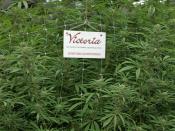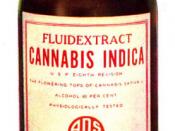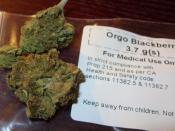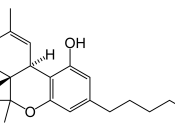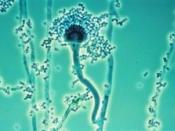The active ingredient in marijuana is the THC which produces the high, which is a feeling of, pleasure a euphoria and wisdom, thoughts flow easily. Marijuana is illegal today but people want to legalize it for medical purposes.
Cannabis is a leafy plant, which grows wild in many of the tropic and temperate areas of the world. It is cultivated both indoors and out for the production of its flowering tops. The most commonly used form of cannabis are the leaves and flowering tops (buds) which may be either smoked or eaten; It also comes in a more concentrated resinous form called hashish, and as a sticky black liquid called hash oil.
There are three distinct species of cannabis: Cannabis sativa, Cannabis indica, and Cannabis ruderalis, though there is some argument as to whether these should be considered varieties rather than species. Most recreationally used cannabis is the result of interbreeding between these three types.
The term 'hemp' is generally used to describe low-thc varieties of cannabis, which are grown for industrial uses.
The strength of cannabis varies greatly from one variety to another. Some, known as 'one-hit-shit', requires only a single lung-full to reach full effects while other varieties require many hits to achieve the same effects. Additionally, the amount that one individual likes to smoke can be many times what another prefers. Generally, 1/8 ounce (3.5 g) of mid-quality bud could get around 20-30 people reasonably high. Cannabis is sold on the street for anywhere between $25 - $150 per 1/4 ounce depending on quality and location. In the U.S., prices are generally $30-$60 for 1/4 ounce of lower quality and $60-$120 for 1/4 ounce of high quality bud. Prices drop quickly as quantity goes up.
Both sales and possession of cannabis are illegal in the United States and most countries, however many states have legalized the medical use of cannabis. Additionally, some states have decriminalized the possession of personal use quantities (under 1/2 - 1 ounce) choosing to punish this with a fine rather than jail time.
The active ingredients in cannabis are called cannabinoids. Marijuana users are eager to ingest the greatest amount of THC, the psychoactive ingredient in marijuana, to achieve the best high. There are many cannabinoids synthesized by the plant including tetrahydrocannabinol, cannabinol, cannabidiol, cannabinolidic acid, cannabigerol, and cannabichromene. Delta-9-tetrahydrocannabinol is thought to be responsible for most of the psychoactive effects of cannabis and is the active ingredient in synthetic THC pills such as marinol.
Cannabis plants do grow wild in many parts of the world, but the quality of wild specimens is generally quite low. Most cannabis is cultivated intentionally and can be grown either indoors or out.
The cannabis plant has been used both medicinally and recreationally for thousands of years. It wasn't until the early 19th century that the use of cannabis spread from China and the Middle East to the population of Europe and then to America in the middle of the century. Cannabis was made illegal in the U.S. in 1937 and has continued to be a popular recreational substance since that time.
When smoked, the effects of cannabis begin almost immediately. When eaten the effects can take 1 to 2 hours to manifest, based primarily on how much food is in the stomach.
The effects of smoked cannabis peak after about 20 minutes and last for 1-2 hours. When eaten, the effects will peak more slowly and primary effects may last for 3-4 hours.
The primary effects sought by those using cannabis recreationally are euphoria, relaxation, and changes in perception. Effects vary depending on dosage, with effects at low doses including a sense of well-being, mild enhancement of senses (smell, taste, hearing), subtle changes in thought and expression, talkativeness, giggling, increased appreciation of music, increased appetite, and mild closed-eye visuals. At higher doses, visuals may become more prominent, sense of time is altered, attention span and memory are frequently affected, and thought processes and mental perception may be significantly altered.
While most people do not experience a strong visual component to the cannabis experience, some do and some particular varieties of cannabis as well as higher doses are more likely to produce this effect. Negative effects can include paranoia, dry mouth, respiratory problems and nervousness/racing heart. Other effects may be negative or inconvenient in certain settings or situations including reduced ability to concentrate, impaired memory, tiredness, and confusion.
Regular use of cannabis can lead to psychological habituation for some people making it difficult for them to quit. Most people do not experience any signs of physical addiction, but with heavy regular use mild withdrawal symptoms can occur for a couple of days. Marijuana has many possible medical uses. Positive effects are claimed for ailments such as cancer, aids, and glaucoma. Aids can cause a loss of appetite known as the "wasting syndrome" which can lead to drastic weight loss and weakness. Chemotherapy used in the treatment of cancer causes nausea resulting in an inability to keep down food. Marijuana's healing nature for these two illnesses is a result of its ability to increase a person's appetite as well as relieving nausea allowing a patient to regain weight. Marijuana reportedly helps glaucoma patients by reducing ocular pressure, which can cause damage to the eye.
